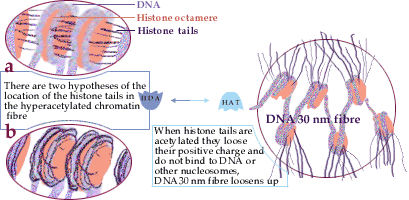A Hypothesis on the Effect on Chromatin by
Acetylation of Histone Tails
The N-terminal tails of the
histone proteins
are protruding from each nucleosome into the
surrounding space. Their location in the
chromatin is not
known today but this picture illustrates two
hypothetical alternatives: a) the positively charged
tails may be contacting negatively charged patches on
neighboring nucleosomes in the 30 nm
chromatin fiber, or
b) the
histone N-terminal
tails may form electrostatic bonds to the negatively
charged phosphate backbone of the DNA helix. Since
there are eight N-terminal tails protruding from each
nucleosome, and since each tail contains several
lysines that may be either acetylated or positively
charged there is ample opportunity for many different
interactions and various structural effects on the
chromatin fiber by
variation of the site of acetylation. In any case,
the
histone acetylation
effectuated by the
enzyme
histone
acetyltransferase
(HAT) will reduce the positive charge of the
histone tails and
hence, be expected to decrease histone/DNA and/or
nucleosome/nucleosome interactions. This would then
lead to a more open
chromatin structure
which is making the DNA more accessible to the
transcription machinery. Conversely, the activity of
histone deacetylase
(HDA) will reestablish the positive charge on the
lysine residues on the
histone tails,
which leads to increased electrostatic interactions
and a tighter packing of the DNA, thus becoming less
accessible for basal transcription factors.
It should be stressed that the picture shown here is
hypothetical and that the structure of the histone
tails in different states of acetylation and its
functions remain to be determined.
|

